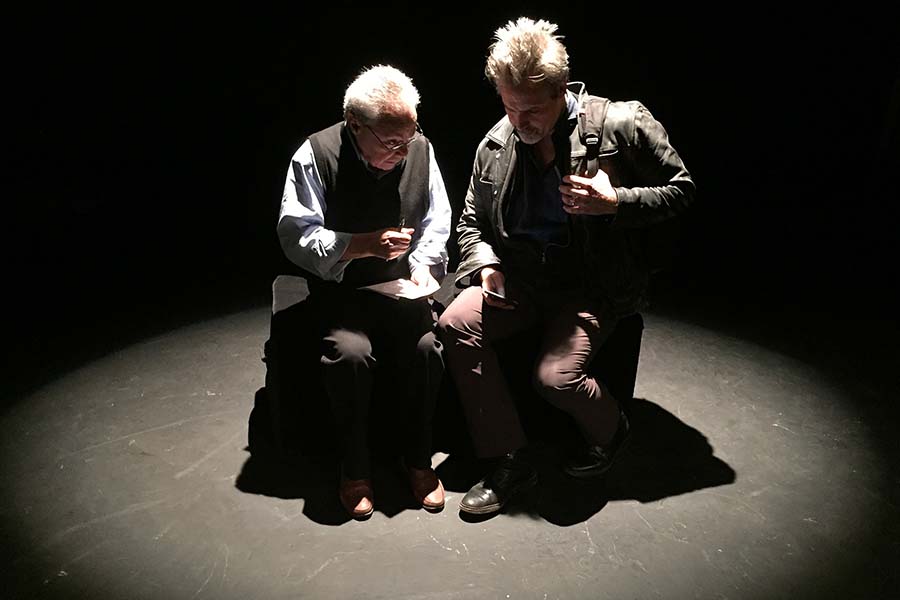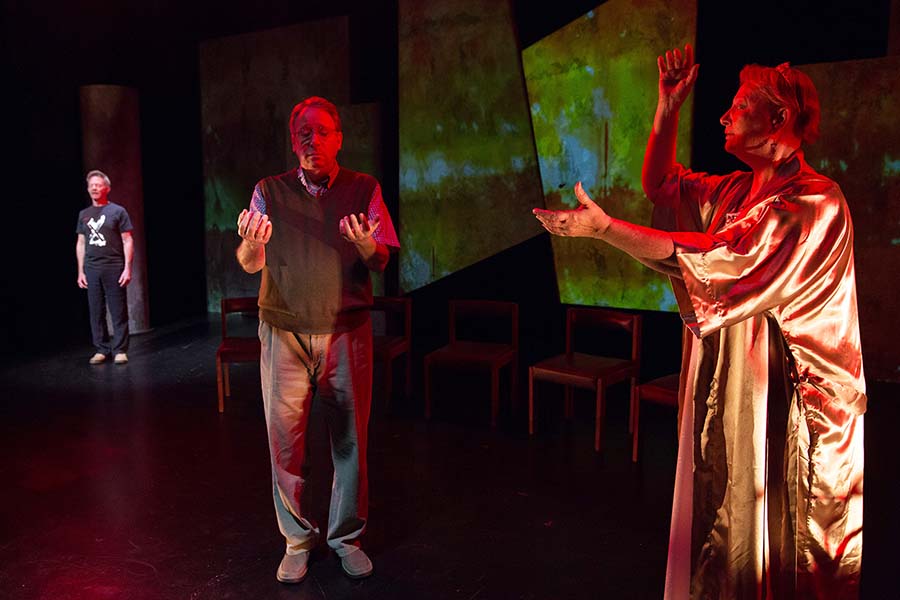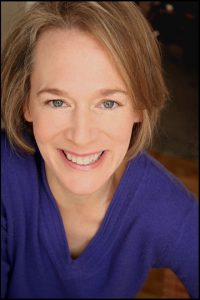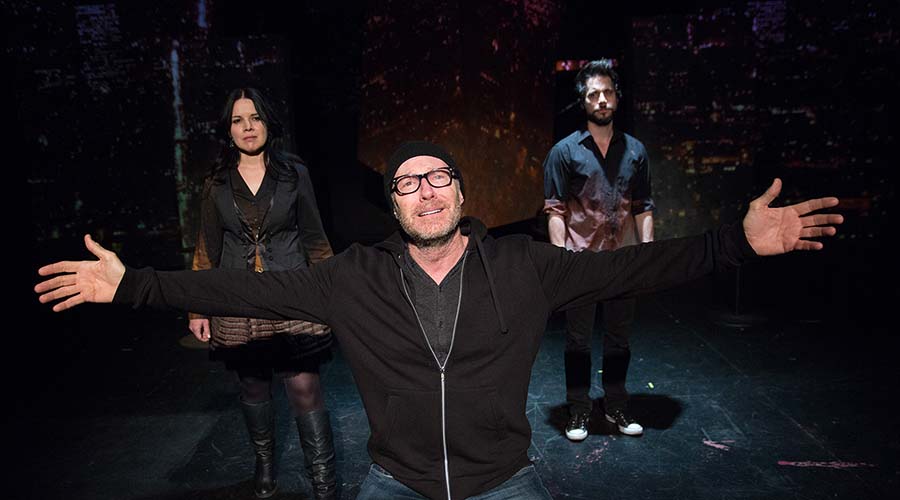It’s said that the theatre is a small world, but L.A. theatre—despite its far-flung breadth and underappreciated quantity and quality—really is a microcosm unto itself, particularly among its smaller companies. So it’s not especially surprising to learn that Murray Mednick, founder of the storied Padua Hills Playwrights Workshop, who later produced a series of definitive works as Padua Playwrights Productions (Joe and Betty, 16 Routines) at various theatres over the decades, has partnered with the Hollywood-based company Open Fist to stage a six-play cycle of his ever-unfurling “Gary Plays,” running May 3-June 4 at Atwater Village Theatre. Los Angeles itself is both setting and subject for Mednick’s interlocking plays, which follow a middle-aged actor (the Gary of the title) through a mysterious, often deadly, occasionally hallucinogenic City of Angels. Longtime Mednick collaborator Guy Zimmerman directs all six of the plays, staged in three programs.
Open Fist, which initially operated out of a capacious space in the heart of Hollywood, then took over the Actors’ Gang’s old shop on Santa Monica Boulevard and El Centro, and is now an itinerant company, has been known for ambitious, large-cast works, from Matei Visniec’s How to Explain the History of Communism to Mental Patients to Frank Zappa’s Joe’s Garage, from Caryl Churchill’s Fen to Mikhail Bulgakov’s Flight.
I spoke to Open Fist artistic director Martha Demson about why she chose to go along with Mednick’s dark, discursive vision, and about how her company is soldiering on against long odds.
I’ve been thinking about you in terms of the recent issues with the L.A. Equity 99-Seat Plan, and the debate about artists getting paid vs. having the chance the self-produce and make their own work. I just wanted to start by asking you where your head is at on that whole argument.
I’m thinking about when I first met Guy Zimmerman. It was in Poland in 2009, and we were both looking at these practitioners of theatre who’d been inspired by Grotowski, some of who had worked with him, others who were just part of the conversation about, what is it to have a community of practice rather than a community of performance? Some of these companies never present anything; they’re sort of like priests of theatre. So in this whole conversation about employment and commerce, we’re trying to insist: What about theatre has not just nonprofit intentions to serve the public good, but purely artistic intentions to serve the artists, the community of artists? What happens if you make it impossible for artists to do their work if they can’t find the money to pay themselves? I hope that continues, and that we provide a place for that to exist.
This is how “The Gary Plays” came to exist.
Right, they incubated over a decade, and that wouldn’t have possible without this community.
It’s my understanding that they started at Padua Hills Playwrights Workshop, or at least in the company that resurfaced from the original playwrights’ festival, right?
Murray founded Padua; he was the driving force. “The Gary Plays” all premiered with Padua Productions. Then Guy came to me about two and a half years ago and asked if I would be interested in reviving these plays, maybe doing a cycle. I was really intrigued. We had lost our space, and were still in the process of working to get our new space built. Guy is directing and Murray is around. It’s interesting to lift them out of Padua and see what we can bring to the table.

Years ago, I saw three of them at the Electric Lodge in Venice: Tirade for Three, Girl on a Bed, and Gary’s Walk.
Oh, I saw those. We’re doing those three and three more. We’re also doing Out of the Blue, where Gary has to go pull the plug on his mother, then visits hell with Antonio, the angel of death. In hell he sees his son, who was murdered, and he has come to grips with that but still finds no peace. In Daddy-O Dies Well, that’s his stepfather, who we met in Out of the Blue, this crazy, aging New Orleans hipster, and he decides he’s going to take Gary on an ayahuasca trip. Meanwhile Gary’s ex-wife is off in Peru, and though they’re apart from each other, they manage to repair the wounds in their relationship and move past the death of their son.
After that, there are two plays: Nightmare Audition, in which Gary is auditioning for some crazy people who are making a low-budget movie, and The Fool and Red Queen. They’re a little bit tangential, and it was going to make the whole thing eight or nine hours long, as opposed to six. So instead for the final episode we’re doing Charles Story, in which the father of Laura, the girl from Girl on the Bed, is in a rehab clinic, and he meets up with Gary, who’s now helping others to heal using theatre. Todd, Gary’s horrible agent, is in rehab as well, and the hills of Malibu are aflame with brush fires. Gary becomes more of a side character in that, but we see he’s finally at peace and in service to others.
That’s a lot!
Yes, and the ambition is to bring all of that together in a way that is dynamic and exciting. I’m thinking of something like The Orphans’ Home Cycle, where before that people might have thought of Horton Foote as, you know, a nice little playwright, and then all of a sudden you have these nine plays, and his work takes on this extraordinary, epic resonance. Likewise, people who think they “get” Murray will feel a little bit differently when they feel the scope of this all put together.
How is it going to be divided up? I know when Latino Theater Company did their “Mexican Trilogy,” they actually split the three plays into two programs.
We had originally thought of that, of doing these in two three-hour performances. But the language is poetic and dense, whatever the length of the plays, so I think this will do better in three parts. You can buy passes to all three, or see just one individual evening with two plays each. We’ll do marathons of all six plays on Sundays.

And you’re doing them chronologically?
We’re doing them in order, but Girl on a Bed is a flashback play—it has the inciting incident, where we meet Danny, Gary’s son. Danny’s murder takes place between that play and Tirade for Three. In Out of the Blue, Gary has to pull the plug on his mother but can’t bring himself to do it until he goes to hell, and there his son tells him to do it. It’s a very funny piece; it has a sort of primitive rhythm to it. But while it’s very funny, I think there’s also some sincere spiritual searching that Gary is doing, and that Murray as a playwright is doing. I really believe he is speaking spiritual truths. His plays are dark, but I think somehow through the practice of theatre itself, he’s speaking to spiritual matters.
And the final play shows someone who’s been released from his narcissism and is using his theatre practice for others. He’s past the stage of La La Land optimism that his art is going to provide its own truth and exuberance. He’s not sure why he keeps doing theatre, but he does. It isn’t an easy resolution, but for Gary it’s been a kind of spiritual liberation. That’s how I experience it.
I remember that different actors played Gary at the Electric Lodge. How many do you have?
We have three Garys. One is doing the first three plays, the second is doing the next two plays, and the last is doing the last play. There are some actors who play those chorus voices, inside voices, they are consistent all the way through. Also the characters that weave through—Antonio (played by Peggy Blow), Dr. Jones, the ex-wives—the same actors play those characters all the way through. And the shows have one director, Guy, and one design team; John Zalewski is scoring.
Can you tell me about the design?
We’re bringing some new things to the production. To me Murray’s language is architectural—it describes the space the plays occupy. To put them in anything other than a black box feels like it might overwhelm the material. But at same time we’re asking people to come and engage for six hours, so we’ve come up with a really elegant design strategy. There are panels that provide surfaces for projections, so we see the literal but also the spiritual environment of the plays. We see the structure of the freeways when Gary’s on his walk, for instance. What’s really interesting to me is that when you think about the plays’ themes of profound alienation, the fragmentation of the psyche, these go with the glimpses of L.A. we see that are recognizable but won’t compete or distract.

I recall Open Fist as having large casts—shows like How to Explain the History of Communism to Mental Patients, or Matthew Wilder’s giant Chuck Mee/Greek tragedy riff, Songs of Joy and Destitution.
Big ensemble casts are very much who we are. We’ve also had very good spaces to play in. We always want to reinvent the space with whatever kind of work we’re doing in it. We had hoped this would be the inaugural production in our new space. We moved out of the old Actors’ Gang space in 2013 and wanted to purchase a new space. We’re still in the process of that development now, but it all takes a long time; we’re nowhere close to done. We had all of the actors ready to go on this, so we finally made a decision to go and not lose the energy of what we had discovered.
So where are you doing it?
We’re at the Atwater Village Theatre, renting from Circle X. We’re learning how to play with others. In the new space we’re planning, Rogue Machine is also going to be coming in, so there are economies of scale but there are also sound-proofing issues. Doing this show at Atwater, where there are also multiple spaces and tenants, gives us an opportunity to see what it’s like.
I saw and enjoyed lots of shows at Open Fist in my time in L.A., but I don’t know much about its history. Can you give me a thumbnail?
Open Fist was founded in 1990, and the founding artistic direct left three or four years later. I took over in about 1997. We tried to run as a collective, and we studied consensus management approaches, but it became really arduous as we grew and grew. It’s just not that practical. Once we’d developed our own member handbook, we moved into a much more traditional theatre structure. So on paper it looks pretty hierarchical. But at heart we are a very egalitarian company—not so much in choosing the material, but I’m not going to choose something that there’s not a general enthusiasm for. We’re a collective of actors, directors, writers, and designers, and we’re all-volunteer organization. We love things that only theatre can do. We love large ensemble shows, not plays with two protagonists and a bunch of spear carriers.
Does the company come from any particular school of theatre, literally or figuratively?
It’s essentially a group of people that have a relationship with the space. We do have a huge number of people from Northwestern and Yale, and people from conservatories. The five founders came out of Cal State Fullerton, actually. But it’s a fairly broad array. It’s basically about theatremakers getting together to make theatre. How do we make meaning together to serve the greater good? It’s more a practice than a philosophy, and it’s about the extraordinary generosity and passion it takes to just make theatre. Which also goes back to Grotowski—the idea of the artists having to find their own way, and within that finding the technical expertise and craftmanship and finding relationship with each other.
Having worked in L.A. theatre for so long, do you have a sense of what makes something distinctively L.A.?
The meaning doesn’t really reside with the artists; the meaning resides with the audience and how it resonates with them, and the conversation that takes place afterward. Here it’s just a whole different experience that’s created; it’s what happens before, during, and after an event that makes up the whole. That’s what is best, and is common, in the L.A. theatre aesthetic.
Bringing this back to the issue of where things are with the Equity 99-Seat Plan—you mentioned “volunteer” a lot, and that’s been a buzzword of theatremakers who want to preserve the old plan, or the non-commercial idea behind it.
It’s about preserving a communal self-producing model. I want to protect the right of the artist to volunteer. We’re a dues-paying organization, and there’s something about investing in what you’re doing. You’re not doing this for the money you’re getting but because it means something to you.
I would love to eliminate the dues and take a small salary. But as a leader I have to say no. This is completely non-commercial. We’ve always been about our space; that’s where the investment has gone. We also pay stipends to designers and reimburse for travel. But that volunteer spirit has always been there, and I’ve thinking about that more during the current debate—it’s probably what’s allowed us to thrive, our version of workers owning the means of production. I want the freedom to develop a piece, and if it has commercial legs, fine, let’s talk about that. But who’s going to take a chance on a Murray Mednick cycle? It has to come from somewhere.


